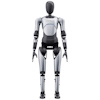Robots have come a long way since their early, rudimentary forms. Today, they permeate our lives in ways we may not even notice. From the automated assembly lines of factories to the personal assistants in our homes, robots are reshaping our world. This comprehensive guide will explore the history, types, applications, and future of these mechanical marvels.
A Brief History of Robotics
The concept of artificial beings with human-like capabilities dates back to ancient myths and legends. However, the modern era of robotics began in the 20th century, with pioneering figures like Isaac Asimov and George C. Devol. Asimov's Three Laws of Robotics laid the foundation for ethical considerations in robot design, while Devol's Unimate became the first industrial robot.
Types of Robots
Robots, once confined to science fiction, are now an integral part of our daily lives and industrial landscapes. From automated vacuum cleaners to sophisticated surgical assistants, the world of robotics is vast and ever-evolving. Understanding the different types of robots is key to appreciating their diverse applications and potential.
These are the workhorses of manufacturing. Designed for repetitive and precise tasks, they are often found on assembly lines.
- Articulated Robots: Resembling human arms, these robots offer flexibility and dexterity, ideal for welding, painting, and assembly.
- SCARA Robots (Selective Compliance Articulated Robot Arm): Optimized for high-speed, precise tasks in assembly and pick-and-place operations.
- Collaborative Robots (Cobots): Designed to work safely alongside humans, cobots are equipped with sensors and safety features, making them adaptable to various tasks.
- Cartesian Robots: These robots move along three linear axes (X, Y, Z), perfect for precise linear motion tasks like CNC machining.
- Delta Robots: Known for their high-speed pick-and-place capabilities, commonly used in packaging and food processing.
2. Mobile Robots:
These robots are designed to move around their environment, often autonomously.
- Autonomous Mobile Robots (AMRs): These robots navigate independently, using sensors and AI to map their surroundings and avoid obstacles. They are used in warehouses, hospitals, and delivery services.
- Automated Guided Vehicles (AGVs): These robots follow predefined paths, often using wires or magnetic strips. They are commonly used in industrial settings for material transport.
- Drones (Unmanned Aerial Vehicles - UAVs): These flying robots are used for aerial photography, surveillance, delivery, and inspection.
- Underwater Robots (Autonomous Underwater Vehicles - AUVs): Designed for underwater exploration and tasks, used in oceanography, oil and gas industries, and military applications.
3. Humanoid Robots:
These robots are designed to resemble humans, both in appearance and movement.
- They are often used for research in human-robot interaction, customer service, and entertainment.
- Advanced humanoid robots may incorporate AI for natural language processing and facial recognition.
4. Service Robots:
These robots are designed to assist humans in various tasks, often in domestic or commercial settings.
- Domestic Robots: Examples include robotic vacuum cleaners, lawnmowers, and pool cleaners.
- Healthcare Robots: Used for surgical procedures, patient assistance, and medication delivery.
- Hospitality Robots: Used in hotels and restaurants for tasks like delivering food and drinks.
- Retail Robots: Used for inventory management, customer service, and shelf stocking.
5. Educational and Research Robots:
These robots are designed to facilitate learning and experimentation in robotics and AI.
- Programmable Bots: Simple robots used to teach basic programming and robotics concepts.
- Modular Robots: Robots with customizable components, allowing for flexible experimentation.
- Advanced Research Platforms: Complex robots used for cutting-edge research in areas like AI, locomotion, and human-robot interaction.
6. Military Robots:
These robots are designed for military applications, often used for reconnaissance, surveillance, and combat.
- Unmanned Ground Vehicles (UGVs): Used for reconnaissance, bomb disposal, and combat support.
- Drones (UAVs): Used for surveillance, reconnaissance, and targeted strikes.
Applications of Robotics
- Healthcare: Robots are used for surgery, rehabilitation, and patient care.
- Manufacturing: Automation has revolutionized industries like automotive and electronics.
- Agriculture: Robots are used for tasks like harvesting, planting, and pest control.
- Exploration: Robots have explored the depths of the ocean, the surface of Mars, and even the human body.
- Education: Robots can be used as teaching aids and research tools.
The Future of Robotics
As technology continues to advance, we can expect robots to become even more sophisticated and integrated into our daily lives. Some potential future developments include:
- Artificial Intelligence: Robots equipped with advanced AI will be capable of complex problem-solving and decision-making.
- Humanoid Robots: Robots that closely resemble humans in appearance and behavior may become more common.
- Robotic Companions: Robots could become our personal assistants, friends, or even family members.
- Ethical Considerations: As robots become more capable, it will be essential to address ethical questions related to their use and development.
Robots have come a long way since their early beginnings, and their potential is limitless. As they continue to evolve, they will undoubtedly play an increasingly important role in shaping our future.



